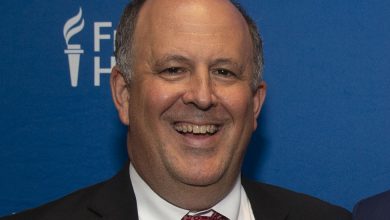Could Wages and Prices Spiral Upward in America?

Amazon, Bank of America and Chipotle are among a spate of companies raising wages this year as they compete for workers in a labor market with more open positions than unemployed job seekers.
But that positive development for workers could morph into a challenge for the Federal Reserve if climbing wages help to keep inflation high, prompting employees to ask for even more money and generating an upward spiral.
So far, many economists think such a situation can be kept at bay. But the Fed is closely monitoring inflation and pay data to assess the risk, because the consequences if wages and prices begin to drive each other steadily higher could be serious, requiring a response from the central bank that could be economically painful.
The Fed is already poised to raise interest rates in March in an attempt to begin cooling off the economy as inflation runs at its fastest pace in 40 years. But if it needed to restrain a self-perpetuating burst in wages and prices, officials might decide to adjust policy more drastically. Higher interest rates could abruptly hit the brakes on lending and spending, potentially sending the United States into recession and foiling central bankers’ hopes of guiding growth gently toward a more sustainable path.
“I think we’re much more likely to have something messier than a magical soft landing,” said Olivier Blanchard, an economist at the Peterson Institute for International Economics. “The wage evolutions are going to be the thing to look at.”
Wages are already rising sharply. Pay for restaurant servers and hotel workers began to increase notably in 2021 as companies, reopening after lockdown, struggled to rehire people quickly. Now a wide array of industries are giving raises: The government’s latest employment report showed pay accelerating sharply for education and health workers, manufacturers, and professional and business services.
Average hourly earnings jumped 5.7 percent in the year through January, a full percentage point more than economists had forecast.
Earnings calls are replete with chief executives explaining that they are increasing pay to attract and retain talent. Unions have won pay bargaining fights. And the White House regularly celebrates signs that power in the work force seems to have shifted toward employees and away from employers.
For the most part, that’s good news for labor. But economists have increasingly warned that the confluence of economic trends shaping up now — high inflation, a sense among consumers that prices might stay high for a while and a strong labor market that has handed workers bargaining power — could set the stage for a situation in which wage growth and prices feed off each other.
“The combination of very high inflation, hot wage growth and high short-term inflation expectations means that concerns about falling into a wage-price spiral deserve to be taken seriously,” Goldman Sachs economists wrote in a note last week.
That would be a big shift. America has not experienced a wage-price spiral since the 1970s and early 1980s, when rapid inflation and skyrocketing wages seemed to perpetuate each other. The Fed lifted interest rates to double digits and caused a painful recession to bring prices under control. Both wage growth and inflation have been slow in the decades since — until now.
But even if wages and prices are both rising now, it is not clear that they are egging each other on yet, which is a crucial distinction. In fact, labor market experts point out three big reasons to doubt that a wage-price spiral will happen today.
Chief among them: Productivity growth looks strong. If each individual worker can churn out more goods and services, companies should be able to pay more without hurting their profit margins and leading them to pass along the higher costs. Nick Bunker, an economist at the Indeed Hiring Lab, said recent productivity data was an encouraging sign but not a definitive one.
“It’s really hard to observe in real time,” he said of the data, noting that the numbers jump around a lot. “I think it’s something to keep an eye on.”
It is also unclear just how much wage bargaining power employees have, even with employers eager to hire. Wage growth appears to have been falling behind price increases for many income groups in recent months, suggesting that workers aren’t managing to persuade their companies to compensate them fully for rising costs. Unionization is much lower than in the 1970s, which could leave workers with fewer tools to bargain up pay.
If that begins to crimp consumers’ ability to buy new couches and cars, it could cause demand to moderate, naturally restraining inflation.
And the tie between wages and prices has been tenuous in recent decades. While research has found a link between the two in the 1960s and 1970s, the relationship collapsed after the early 1980s and has remained tame since.
“The relationship between wage growth and services inflation just isn’t that tight,” said Laura Rosner-Warburton, an economist at MacroPolicy Perspectives. “Yes, you will see more inflation from wages in 2022. The question is how much?”
While a wage-price spiral is on a “large list of risk factors” that the administration is closely watching, the “dominant forecast” is that the labor market will stay strong and price gains will moderate this year, said Jared Bernstein, a member of the White House Council of Economic Advisers.
Wall Street economists generally think inflation will fade toward 3 percent this year, based on recent analyst notes and interviews. A recent survey from the Federal Reserve Bank of New York showed that consumers, who had been penciling in higher inflation in the years ahead, have begun to lower their expectations for price increases.
But several forecasters said there was room for humility and wariness, because the pandemic economy has repeatedly confounded expectations. It has also drastically changed America’s economic backdrop.
“The last 20 years have been years of very low inflation, very stable inflation,” Mr. Blanchard said. Before the coronavirus, inflation had hovered around — and then below — 2.5 percent for decades. Today, it has jumped to 7.5 percent.
As prices for products including gas, steaks, bacon and camping equipment climb rapidly, eating into paychecks and dominating headlines, consumers are more likely to take note and ask for better pay.
“Things change completely when inflation is a big number,” Mr. Blanchard said. “Salience changes.”
There are signs that wages are feeding into price increases, at the margin. Prices have recently begun to rise sharply for core services, a set of purchases outside of health care, rent and transportation for which wages tend to make up a major cost of production.
“That was concerning,” said Alan Detmeister, an economist at UBS who formerly led the Fed’s wage and price section. But, he added, it is hardly conclusive.
More anecdotally, stories of workers winning big wage increases in a tight labor market abound.
While wages in lower-qualification fields like leisure and hospitality have been rising rapidly for months, professional pay may also be on the cusp of picking up: Banks have been making big base salary increases, and Amazon will raise its maximum base salary for corporate and technology workers to $350,000 from $160,000 as it competes for a limited pool of highly trained employees.
Amazon, which has also increased wages for warehouse employees, has raised prices partly in response.
“With the continued expansion of Prime member benefits and the increased member usage that we’ve seen, as well as the rise in wages and transportation costs, Amazon will increase the price of our Prime membership in the United States,” Brian T. Olsavsky, the company’s chief financial officer, said on a Feb. 3 earnings call. The monthly price is rising to $14.99 from $12.99, and the annual membership is jumping to $139 from $119.
“This is our first price increase since 2018,” Mr. Olsavsky noted.
Other companies are raising pay but have said they are covering the climbing costs by improving efficiency. That’s the sort of sweet spot the White House and the Fed are hoping for, because it could leave workers earning more without pressuring prices relentlessly up.
“We do anticipate when we do our annual review process that we will have a nominally higher wage rate increase provided to our associates,” Kevin Hourican, president and chief executive at the food distributor Sysco, said on a Feb. 8 earnings call. “And we have productivity improvement efforts that can help offset those types of increases.”



